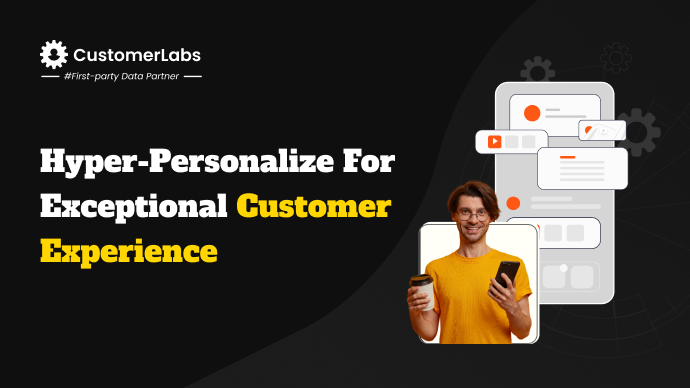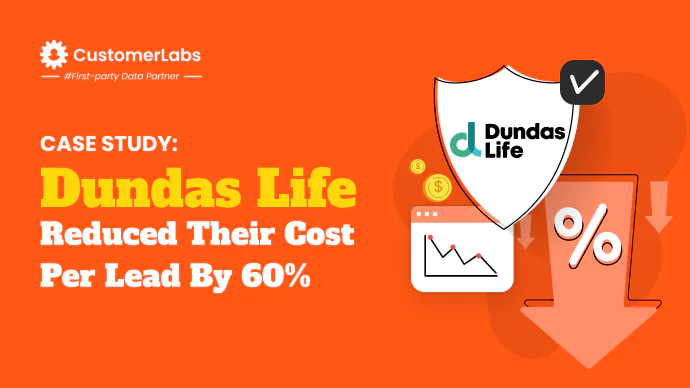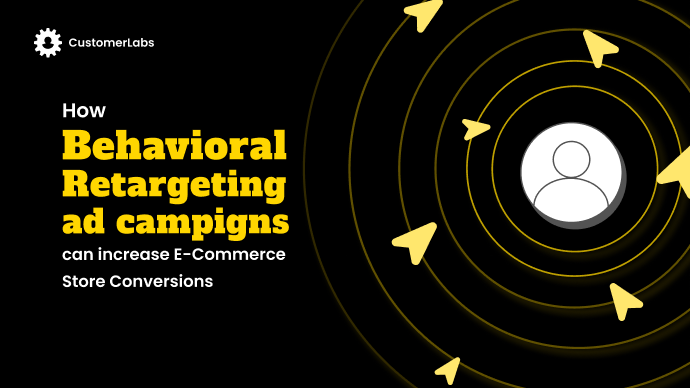
Customer experience (CX) is essential to business success, shaping perceptions and promoting customer loyalty. Delivering exceptional customer experience involves consistently exceeding customer expectations at every touchpoint, creating positive emotions and lasting impressions. To achieve this, hyper-personalization is one of the key factors, among others!
Businesses prioritizing customer experience gain a significant edge, leading to consumer satisfaction, loyalty, and positive brand perception.
So, what are the elements of a positive customer experience?
Convenience
According to a report by Ericsson-LG Enterprise, 81% of consumers are willing to pay more for a guaranteed good experience.
Responsiveness
A survey by HubSpot found that 90% of customers rate an “immediate” response as essential when they have a customer service question.
Consistency
In a study by Zendesk, 61% of consumers said they are unlikely to return to a brand after just one bad experience.
Personalization
A study by Epsilon suggests that 80% of customers are likely to buy when brands offer personalized experiences.
Hyper-Personalization in CX
Hyper-personalization takes personalization to a new level. It involves customizing products, services, and content to each customer’s preferences, creating a unique and customized experience for each customer.
While traditional personalization often relies on broad customer segments, hyper-personalization drills to the exclusive level. It utilizes real-time data and advanced technologies to create highly targeted and valuable interactions.
Hyper-personalization significantly enhances customer experience by delivering what customers want when they want it. It creates a connection and understanding, leading to increased satisfaction and loyalty. Fueled by insights from first-party data, hyper-personalization is an essential strategy for achieving an exceptional customer experience.
First-party data in hyper-personalization
First-party data is information gathered directly from customers as a result of their interactions with a company. It includes valuable insights that contribute to creating personalized experiences, such as;
Customer preferences
- Direct feedback through surveys and preference settings.
- Tracking product/service preferences based on purchase history.
Behavioral data
- Analyzing website interactions, click-through rates, and navigation patterns.
- Understanding their purchase preferences and behaviors.
- Analyzing the entire customer journey.
Interaction history
- Keeping a record of customer support interactions.
- Tracking activities across various channels, such as email and chat.
When you bring in data across multiple touch points, interactions across CRM, website, PoS, at one place, it becomes easy to offer personalized experiences to the customers. A first-party data partner like CustomerLabs will help you do that seamlessly across any platform such as Google Ads, Meta Ads, etc.
4 Benefits of hyper-personalization in customer experience
Advantages of leveraging hyper-personalization in customer experience:
1. Improved customer satisfaction and loyalty
By delivering personalized experiences, businesses meet each customer’s needs, surpassing generic offerings. Customized interactions also promote loyalty, encouraging customers to choose a brand consistently.
2. Increased customer interaction
Hyper-personalization enhances interaction by providing content and experiences that cohere with each customer. Moreover, interactive and personalized campaigns motivate consumers to participate actively, contributing to a positive customer experience.
3. Higher conversion rates
Personalized experiences guide customers seamlessly through the buying process, reducing friction and boosting activity rates. Recommending products based on each customer’s preferences increases the likelihood of conversion.
Personalization is the key factor that drives higher conversion rates on Ad platforms. For example, when you segment the audience based on their behavior, and show them ads relevant to them, the user will purchase it. To give you a scenario, let us assume that a user adds to cart a red shirt but does not make the purchase. Now, when you send this data to Meta through a privacy compliant way, the Conversions API, Meta will identify that user. Now, you can use that product in your ad creative and show the red shirt to the user. As the user is already aware of the product and is convinced to almost buy, it becomes easier for you to convert them.
4. Positive impact on brand perception
Businesses adopting hyper-personalization are perceived as customer-focused, enhancing brand image. Satisfied and happy customers are also more likely to become brand advocates, promoting the company to others.
8 Strategies for implementing hyper-personalization
The following strategies will help you get started with hyper-personalization:
1. Creating customer personas for targeted personalization
Customer personas help businesses understand their consumers on a deeper level. By collating and analyzing demographic, psychographic, and behavioral data, businesses can customize their offerings to match the preferences and needs of specific customer segments.
Personas are the basis for crafting personalized content, recommending products, and developing communication strategies. For example, a persona based on tech-savvy millennials might prompt the creation of interactive and visually appealing content.
2. Real-time personalization based on customer behavior
Real-time personalization involves adapting interactions based on current customer behavior. For instance, a retail website may adjust product recommendations instantly as a customer browses, increasing the likelihood of a purchase.
Examples:
Dynamic content delivery
News websites dynamically adjust content based on user preferences, ensuring the site displays the most helpful articles.
Pricing adjustments
eCommerce platforms dynamically update prices based on user behavior, such as adjusting discounts or promotions in real-time.
Personalized offers
Travel websites provide real-time, personalized offers based on user searches and preferences, enhancing the booking experience.
3. Utilizing technology for data analysis
Machine Learning
Machine learning (ML) algorithms process large datasets, recognizing patterns and predicting exclusive preferences. Examples include recommendation engines, which analyze user behavior to suggest products or content, and predictive analytics that forecast customer needs. Here are some instances of machine learning applications;
Recommendation engines:
Amazon’s product recommendations are driven by ML algorithms that analyze browsing history, purchase patterns, and similar user behaviors to suggest personalized products.
Predictive analytics:
eCommerce platforms use predictive analytics to forecast customer preferences, enabling inventory optimization and personalized marketing. One such use case of eCommerce also highlights the use of predictive LTV of a customer and targeting these high value customers using value-based bidding in Google Ads.
Artificial Intelligence
AI-powered tools like chatbots, AI Avatar, and virtual assistants enhance customer interactions by understanding queries and providing personalized responses.
AI-driven chatbots offer real-time assistance, answering queries and guiding users through personalized interactions. Virtual assistants, like Siri or Google Assistant, utilize AI to understand user preferences and provide customized recommendations.
4. Integrating hyper-personalization across multiple touchpoints
Consistency across various touchpoints, including websites, mobile apps, email campaigns, and social media, is vital for a unified customer experience. Inconsistencies can lead to confusion and dissatisfaction. Below are some examples:
Websites
eCommerce platforms display personalized product recommendations on the homepage, reflecting the user’s browsing and purchase history.
Mobile apps
Retail apps send personalized push notifications based on user preferences, promoting valuable deals and new products.
Email campaigns
Companies send targeted emails featuring personalized content, such as exclusive discounts or product recommendations customized to the recipient’s preferences.
Social media platforms
Businesses utilize targeted ads on social media, leveraging user data to create content relative to customer preferences.
5. Video marketing for personalized content
Video content provides a rich and engaging medium for personalized communication. Businesses can use AI to analyze user preferences or an AI-powered online video editor to create content that matches each customers’ interests.
Streaming services analyze viewing history and preferences to recommend personalized video content, creating a more immersive and enjoyable experience.
6. Contextual marketing through location-based personalization
Location-based personalization enhances customer experience by providing contextually helpful information based on the user’s location. This strategy is specifically effective for businesses with physical locations.
Examples:
Geotargeting
Retailers send location-based promotions to customers’ smartphones when they are near a physical store.
Beacon technology
Shopping malls use beacons to send visitors personalized offers and navigation assistance based on their location within the mall.
7. Feedback-driven personalization
Consumer feedback is a useful source of data for improving personalization efforts. By actively seeking and analyzing feedback, businesses can refine their strategies and better meet customer expectations. You can offer a reward to your customers in exchange for their information or the users themselves provide you with valuable information about their preferences. This is called zero-party data and is the most valuable data.
Regular feedback loops enable businesses to adapt their personalization strategies based on changing customer preferences, ensuring a continuous improvement cycle.
8. Personalized loyalty programs
Traditional loyalty programs are becoming more personalized, offering personalized rewards and incentives based on each customer’s preferences and purchasing behavior.
Airlines, for example, may offer personalized loyalty rewards such as seat upgrades or additional perks based on a customer’s travel history and preferences.
Examples Of Successful Hyper-Personalization Implementations
1. Amazon
Amazon’s email campaigns are personalized based on customer preferences and behavior. Users receive emails showcasing products related to their past purchases and exclusive deals customized to their purchasing history.
2. Netflix
To suggest highly personalized content, Netflix’s recommendation engine considers exclusive viewing history, genre preferences, and user ratings. By analyzing vast datasets, Netflix provides users with content customized to their tastes, increasing overall user satisfaction.
3. Spotify
Spotify’s algorithms analyze user listening habits, considering factors such as favorite genres, artists, and recently played tracks. This data-driven approach enables Spotify to curate personalized playlists like “Discover Weekly” and “Daily Mix.”
Trends In Hyper-Personalization For Customer Experience
As technology develops, its impact on customer experience (CX) through hyper-personalization is expected to be augmentative. Several trends are shaping the future of customer experience:
Augmented, Virtual Reality and Mixed Reality
- Integration of AR and VR into the customer journey for immersive and personalized experiences.
- Virtual try-ons for products, AI avatar generator tools, virtual tours of physical spaces, and interactive AR elements enhance interaction.
Internet of Things (IoT)
- The growing use of IoT devices to collect real-time data on customer preferences and behavior.
- Personalization is based on data from smart home devices, wearables, and other connected gadgets.
5G Technology
- Faster and more reliable connectivity enables real-time data processing and instant personalization.
- Enhanced capabilities for delivering high-quality, personalized content without lag.
Voice and Conversational AI
- Expansion of voice-activated technologies, AI voice generator, and conversational AI for more natural and personalized interactions.
- Personalized voice assistants anticipate user needs and preferences.
Takeaways
In conclusion, delivering exceptional customer experience remains vital in the business industry. As highlighted throughout this discussion, hyper-personalization is essential to achieve this goal.
The integration of hyper-personalization is not just a trend; it’s a fundamental shift in how businesses interact with their customers. Companies can customize experiences to each customer’s preferences, promoting loyalty and satisfaction, by utilizing advanced technologies and data analytics.
As businesses navigate the changing landscape of customer expectations and technological advancements, the encouragement is to prioritize customer experience through a dual focus on hyper-personalization and responsible use of first-party data. By doing so, companies can meet and exceed customer expectations, build lasting relationships, and stay competitive in the dynamic marketplace in compliance with data privacy regulations.
However, with increasing concerns over data privacy, personalization becomes a hurdle. To navigate it, being a part of 1PD Ops is mandatory. Every business must adopt the first-party data strategies powered by first-party data operations to witness the hyper-personalization in the data privacy-centric era.







